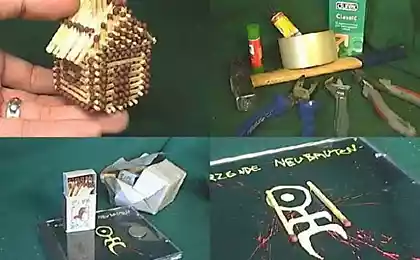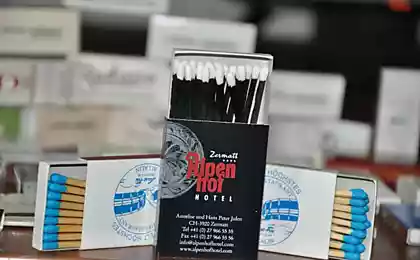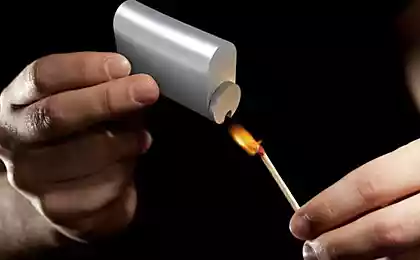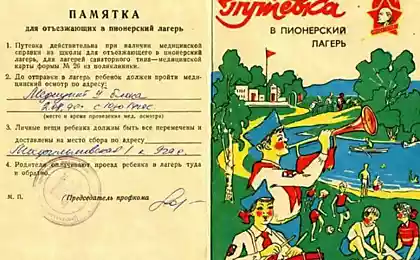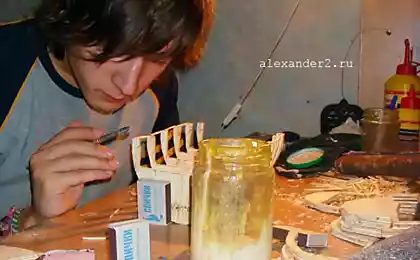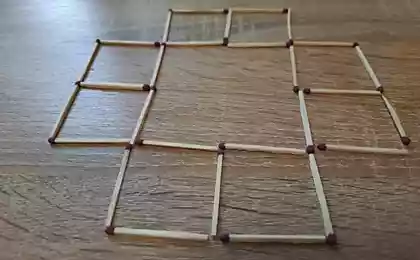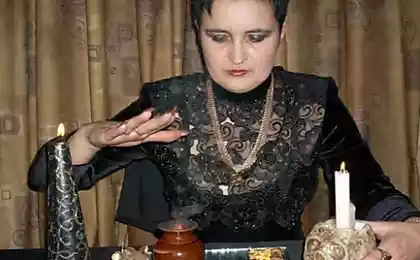1191
The history of matches (16 photos)
"What kind of a man without matches? As x @ nd without testicular »
Matches - a relatively recent invention of mankind, they have replaced the flint about two centuries ago, when he worked looms, went trains and steamships. But only in 1844, it announced the establishment of safety matches.
Before the hands of man by man broke the match was a lot of events, each of which has contributed to the long and easy ways to create a match.
Although the use of fire goes back to the dawn of humanity, it is believed that the original match was invented in China in 577, with the Qi Dynasty, which ruled in the northern part of China (550-577). The courtiers were in the military siege and left without fire invented them from the sulfur.
But let's find out the story of the everyday little things more ...

description of these matches give Tao Gu in his book "Evidence of extraordinary and supernatural" (approx. 950 years old):
"If something unexpected happens overnight, it takes some time. Insightful people simplify small stick soaked gray pine. They were ready for use. It remains only to rub them on the uneven surface. It turned out the flame, as big as wheat ear. This miracle is called "slave, wearing a light." But when I started to sell them, he called them sticks of fire ". In 1270 the match already sold freely on the market in Hangzhou.

In Europe, only the matches were invented in 1805 by French chemist Chancel, although it was in 1680, Irish physicist Robert Boyle (opens Boyle), covered a small piece of phosphorus and took the already known to us a wooden stick with sulfuric head. He rubbed it on paper, and as a result of the fire broke out
The word "match" comes from the old Russian word spoke - acuminata wooden stick or a splinter. Originally called spokes wooden nails, which are attached to the sole of the shoe. The first match in Russia called "incendiary or samogarnye match».
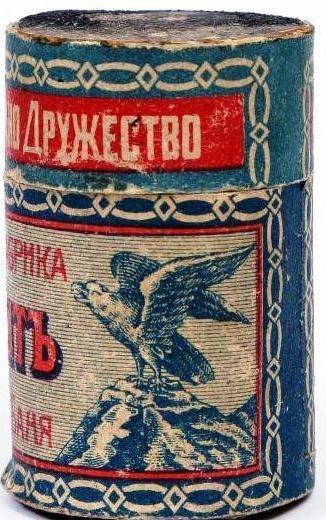
Chopsticks are as wooden matches (apply soft woods - linden, aspen, poplar, American white pine ...) and cardboard and wax (paraffin-impregnated cotton harness).
Collecting matchbox labels, boxes of matches themselves and other objects associated with them are called Filumeniya. Their collectors are called phillumenists.
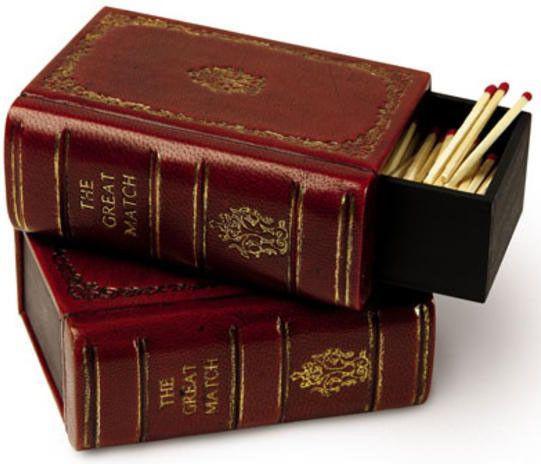
By the method of ignition matches are scratch wire that ignited by friction on the surface of a matchbox and bestёrochnye that are lit on any surface (remember Charlie Chaplin lit a match on his trousers).
In ancient times to make fire, our ancestors used the friction of wood on the tree, and then began to use flint and steel was invented. But with him a rousing fire took time, effort and skill known. Blow came on flint carved gets on nitrate soaked tinder spark. He began to smolder and already with him, with the help of dry kindling, fire fanned
Another invention was propitayvanie dry kindling molten sulfur. When sulfuric head pressed to the smoldering tinder, she flashed. And from her hearth had burned. So there was a prototype of the modern matches.
In 1669, it was opened by the friction flammable white phosphorus, which was used in the production of the first match heads.
In 1680, Irish physicist Robert Boyle (1627 - 1691 gg.otkryvshy Boyle), covered such a small piece of phosphorus and took the already known to us a wooden stick with sulfuric head. He rubbed it on paper, and as a result of the fire broke out. But unfortunately no useful output from this Robert Boyle did.
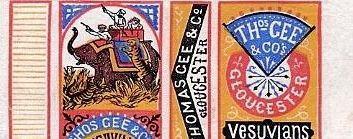
Invented in 1805 wooden matches Shapselya had head from a mixture of sulfur, potassium chlorate and is used to color the head in red cinnabar. This lit a match or use a magnifying glass from the sun (remember as a child vyzhigaali pictures, or set fire to a blueprint), or dripping on it with concentrated sulfuric acid. His matches were dangerous to use and very expensive.
A little later he, in 1827, the English chemist and druggist John Walker (1781-1859) discovered that if you cover the end of a wooden stick to certain chemicals, the teals it on a dry surface, head lights up and ignites the wand. Chemicals that he used were the following: antimony sulfide, bertoletova salt, gum, and starch. Walker did not patent his «Congreves», as he called it invented the world's first matches, which were lit from friction.
An important role in the birth of the matches played by the discovery of white phosphorus, made by a retired soldier from Hamburg Henning Brandt in 1669. Having studied the works of the famous alchemists of the time, he decided to get the gold. As a result, the experiments accidentally turned a light powder. This substance had amazing properties of light, and Brand called it "phosphorus", which translated from Greek means "light-bearing».
As for Walker, then, as often happens, the pharmacist invented a match by chance. In 1826, he mixed chemicals with a stick. At the end of the stick form a dried droplet. To remove it, he struck his stick on the floor. Fire broke out! Like all unsophisticated web browsers, he had not bothered to patent his invention, and showed it to all comers. A guy named Samuel Jones was present at this demonstration and realized market value of the invention. He called the match "lyutsiferchiki" and began to sell them tons, despite the fact that "lyutsiferchikami" were some of the problems are related - they smelled bad and fire scattered around the cloud of sparks.
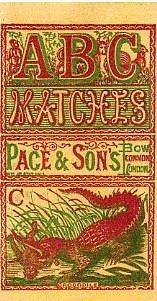
Soon he released them on the market. The first sale of matches was held April 7, 1827 in the city of Hicks. Walker earned a little money thanks to his invention. His matches n «Congreves», but often exploded, and unpredictably were dangerous to handle. He died in 1859 at age 78 and was buried in the cemetery of the parish church in Norton Stockton.
Soon, however, matches Walker «Congreves» Samuel Jones saw and decided to also start selling them, calling them «Lucifers». Perhaps because of its title matches «Lucifers» became popular, especially among smokers, but they also had an unpleasant odor when burning
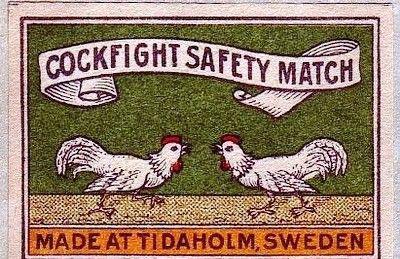
There was one problem - the first matches was the head of one of phosphorus, which is great flammable, but burnt out too quickly and wooden stick is not always time to light up. I had to go back to the old recipe - sulfuric head, and already it began to apply phosphorus to make it easier to burn sulfur, which in its ocheredt set fire to the wood. Soon we came up with yet another improvement of a match head - to phosphorus began to mix with the heated oxygen-releasing chemicals.
In 1832 in Vienna appeared dry matches. They were invented by L. Trevani, he covered the head with wooden straw mixture Berthollet salt with sulfur and glue. If such a match to hold on sandpaper, then head ignited, but sometimes it happened with the explosion, and this has led to serious burns.
Ways of further improvement of the matches were very clear: it is necessary to make such a composition of the mixture to a match head. This comes to calm. Soon the problem was solved. The new members were bertoletova salt, white phosphorus and glue. Matches with such a coating is easily ignited on any hard surface, on the glass, on the sole of the shoe, a piece of wood.
The inventor of the first phosphate matches proved Nineteen Frenchman Charles Soria. In 1831, the young experimenter to a mixture of potassium chlorate with sulfur to weaken its explosive properties of white phosphorus added. This idea has been successful because the resulting compositions smeared splinter easily ignited by ignition trenii.Temperatura such matches is relatively small - 30 gradusov.Uchёny wanted to patent his invention, but for this it was necessary to pay a lot of money, which he had not. A year later, the match was re-established by the German chemist Ya.Kammererom.
These matches matches easily ignited, so we were the appearance of fire, and besides, white phosphorus is very poisonous substance. Operating match factories suffered serious illnesses caused by phosphorus pairs.
The first successful recipe for the mass production of incendiary phosphorous matches are likely to come up with the Austrian Irini in 1833. Irini offered his employer Roemer, who opened the match factory. But wearing loose match was uncomfortable and then to light a matchbox with a rough glued to paper. Now it did not need to strike sharply phosphoric match of horrible. The only problem remains in the fact that sometimes due to friction in the box lit matches.
In connection with the danger of self-ignition of phosphorus matches began the search for a more convenient and secure flammable substances. Opened in 1669 by the German alchemist Brandt white phosphorus was easier to ignite than sulfur, but the downside was that it is a strong poison and burning gave a very unpleasant and harmful odors. The workers of match factories, inhaling vapors of white phosphorus, just a few months turned into invalids. In addition, dissolving it in water, received the strongest poison, which could easily kill a human.

In 1847, Schroeter discovered red phosphorus, which was no longer toxic. So gradually it began replacing toxic white phosphorus in matches on red. The first fuel mixture based on it created a German chemist Boettcher. He made a head match on the basis of glue from a mixture of sulfur and potassium chlorate, and the match itself infiltrated with paraffin. Match burned great, but the only drawback was that she had not ignited by friction on a rough surface. Then Boettcher smeared the surface composition containing red phosphorus. In sliding head matches, it contains particles of red phosphorus ignited, setting fire to light up a match head and steady yellow flame. These matches did not allow no smoke, no odor phosphorous matches.
The invention Boettcher not initially attracted the attention of industrialists. For the first time he began to produce a match in 1851, the Swedes brothers Lundstrem. In 1855, Edward Johan Lundstrom patented in Sweden their matches. Therefore, the "safety matches" and began to be called "Swedish».
The Swede struck the red phosphorus on the surface of sandpaper outside the small box and added the same phosphorus in the head of a match. Thus, they are not harmful to health and is easily lit on the previously prepared surface. Safety matches in the same year were presented at the International Exhibition in Paris, and received a gold medal. Since then, the beginning of the match triumphal march around the world. Their main feature was that they were not ignited by friction of any solid surface. Swedish Match ignited only if it rubbed on the side surface of the box, covered with a special mass.
Shortly thereafter, Swedish Match began to spread around the world and soon in many countries has been banned production and sale of health hazardous phosphorous matches. After a few decades, the release of phosphorus matches completely stopped.
In America, the history of the production of their own matchbox began in 1889. Joshua Pusey (Joshua Pusey), of Philadelphia invented the matchbox and called it «Flexibles». To this day never came no information on the number placed in the box of matches. There are two versions - they were 20 or 50. The first American matchbox he made of cardboard with scissors. In a small wood stove he cooked mixture to head matches and cover the surface of the box another bright mixture to ignite them. Beginning in 1892, Pusey spent the next 36 months, the priority of defending in the courts of its opening. As often happens with great inventions, the idea has been in the air and at the same time, other people also worked on the invention of a matchbox. Patent Puxi unsuccessfully contested the Diamond Match Company, which invented a similar matchbox. As an inventor, not a fighter, in 1896 he agreed to the proposal of Diamond Match Company to sell her his patent 4, 000 $ in conjunction with a proposal to work in this company. Sue was because of that, because already in 1895 the production volumes exceeded 150,000 matches Matchbox day.
Pusey went to work in the Diamond Match Company and worked there until his death in 1916. Despite the fact that until 1896 the company produced other similar matchboxes invention Puxi has received worldwide recognition.
In 1910 in the US the same Diamond Match Company patented a completely non-toxic matches, which use safe chemical called sesquisulfide phophoroues.
US President William Taft publicly asked Diamond Match Company to transfer its patent for the benefit of mankind. January 28, 1911, the US Congress has set a very high tax on matches, made on the basis of white phosphorus. In this era in America over phosphorous matches.
The earliest known commercial advertising on matchbooks in America was founded in 1895 and promoted the company Mendelson Opera Company. «A cyclone of fun - powerful caste - pretty girls - handsome ward-robe - get seats early.» Top matchbox was a photograph of the stars of this comic troupe, trombonist Thomas Louden signed "The young comic opera of America." Opera Company acquired the Diamond Match Company box 1 Matchbox (about 100 pieces) and actors sitting at night, pasted pictures on them and their primitive advertising. Recently, the only remaining of the 100 made that night boxes of matches was sold for 25 000 $.
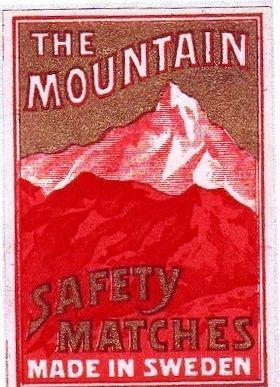
This idea was quickly picked up and orientation have gone to a big business. They turned out to Pabst Brewery in Milwaukee, ordered ten million matchboxes.
Next was advertising Tobacco King Duke (Duke). He purchased his advertising for thirty million boxes. After a moment, William Wrigley - King of chewing gum Wrigley's Chewing Gum ordered one billion Matchbox advertising his chewing gum.
The idea to advertise on a matchbox belonged to the young seller Diamond Match Company, Henry Trout (Henry C. Traute). Trout picked up the idea in the United States other releases of the match and it brought huge profits for the first twenty years of the 20th century. In the late 1920s, tens of thousands of advertisers using matchboxes, which became the most popular form of advertising in America.
But came the Great Depression and money to advertise their products, companies already died. Then the Diamond Match Company came up with the next move in the beginning of 1932 it has placed on their cases your own advertisement in the form of photos of Hollywood movie stars. On "the smallest billboard in the world," adorned with photos of American movie stars: Katharine Hepburn, Sliema Sommerville, Richard Arden, Ann Harding, Zazu Pitts, Gloria Stuart, Constance Bennett, Irene Dunne, Frances Dee and George Raft.

The rest already a matter of technique. After the success of the first series were sold for a penny, Diamond released matchboxes with several hundred national celebrities. Photos of movie stars and radio were supplemented on the back of a matchbox their brief personal biography.
Then came the athletes, patriotic and military advertising, popular American heroes, football, baseball and hockey teams ... The idea was picked up around the world and a matchbox in all countries has become a window of advertising and promotion.
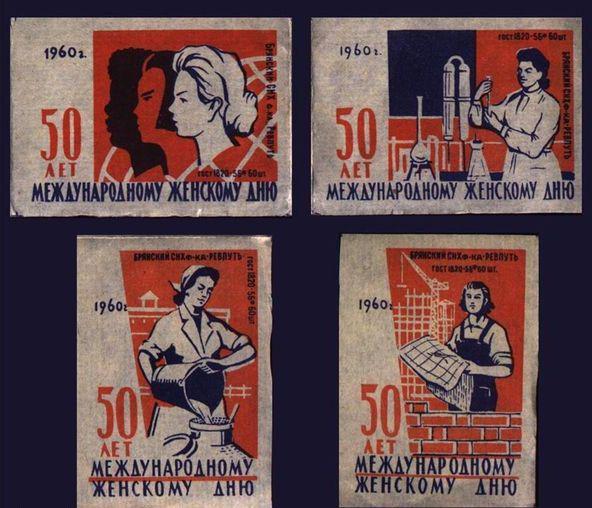
But perhaps the United States became the only country. where in the 40s to a pack of cigarettes he was given a complimentary box of matches. They were an integral part of every purchase cigarettes. The price of a matchbox, has not increased in the United States for fifty years. So rise and fall of a matchbox in the United States to track the number of packs of cigarettes sold.
In Russia the match came in the 30s of the 19th century and sold for a hundred rubles in silver ... Later there were the first matchboxes, first wood and then tin. And even then they glued labels, which led to the emergence of a whole branch of collectibles - phillumeny. The label bore not only the information, but decorated and complemented the match.
The number of factories releasing them to the exit in 1848, the law allows their production only in Moscow and St. Petersburg reached 30. The following year she worked only one match factory. In 1859, the law abolished the monopoly and in 1913 in Russia operated 251 factory producing matches.
Modern wooden matches are made in two ways: veneer method (for matches square) and the die (for matches of round section). Small aspen or pine chocks or schepyatsya or stamped match machine.
Matches - a relatively recent invention of mankind, they have replaced the flint about two centuries ago, when he worked looms, went trains and steamships. But only in 1844, it announced the establishment of safety matches.
Before the hands of man by man broke the match was a lot of events, each of which has contributed to the long and easy ways to create a match.
Although the use of fire goes back to the dawn of humanity, it is believed that the original match was invented in China in 577, with the Qi Dynasty, which ruled in the northern part of China (550-577). The courtiers were in the military siege and left without fire invented them from the sulfur.
But let's find out the story of the everyday little things more ...

description of these matches give Tao Gu in his book "Evidence of extraordinary and supernatural" (approx. 950 years old):
"If something unexpected happens overnight, it takes some time. Insightful people simplify small stick soaked gray pine. They were ready for use. It remains only to rub them on the uneven surface. It turned out the flame, as big as wheat ear. This miracle is called "slave, wearing a light." But when I started to sell them, he called them sticks of fire ". In 1270 the match already sold freely on the market in Hangzhou.

In Europe, only the matches were invented in 1805 by French chemist Chancel, although it was in 1680, Irish physicist Robert Boyle (opens Boyle), covered a small piece of phosphorus and took the already known to us a wooden stick with sulfuric head. He rubbed it on paper, and as a result of the fire broke out
The word "match" comes from the old Russian word spoke - acuminata wooden stick or a splinter. Originally called spokes wooden nails, which are attached to the sole of the shoe. The first match in Russia called "incendiary or samogarnye match».

Chopsticks are as wooden matches (apply soft woods - linden, aspen, poplar, American white pine ...) and cardboard and wax (paraffin-impregnated cotton harness).
Collecting matchbox labels, boxes of matches themselves and other objects associated with them are called Filumeniya. Their collectors are called phillumenists.

By the method of ignition matches are scratch wire that ignited by friction on the surface of a matchbox and bestёrochnye that are lit on any surface (remember Charlie Chaplin lit a match on his trousers).
In ancient times to make fire, our ancestors used the friction of wood on the tree, and then began to use flint and steel was invented. But with him a rousing fire took time, effort and skill known. Blow came on flint carved gets on nitrate soaked tinder spark. He began to smolder and already with him, with the help of dry kindling, fire fanned
Another invention was propitayvanie dry kindling molten sulfur. When sulfuric head pressed to the smoldering tinder, she flashed. And from her hearth had burned. So there was a prototype of the modern matches.
In 1669, it was opened by the friction flammable white phosphorus, which was used in the production of the first match heads.
In 1680, Irish physicist Robert Boyle (1627 - 1691 gg.otkryvshy Boyle), covered such a small piece of phosphorus and took the already known to us a wooden stick with sulfuric head. He rubbed it on paper, and as a result of the fire broke out. But unfortunately no useful output from this Robert Boyle did.

Invented in 1805 wooden matches Shapselya had head from a mixture of sulfur, potassium chlorate and is used to color the head in red cinnabar. This lit a match or use a magnifying glass from the sun (remember as a child vyzhigaali pictures, or set fire to a blueprint), or dripping on it with concentrated sulfuric acid. His matches were dangerous to use and very expensive.
A little later he, in 1827, the English chemist and druggist John Walker (1781-1859) discovered that if you cover the end of a wooden stick to certain chemicals, the teals it on a dry surface, head lights up and ignites the wand. Chemicals that he used were the following: antimony sulfide, bertoletova salt, gum, and starch. Walker did not patent his «Congreves», as he called it invented the world's first matches, which were lit from friction.
An important role in the birth of the matches played by the discovery of white phosphorus, made by a retired soldier from Hamburg Henning Brandt in 1669. Having studied the works of the famous alchemists of the time, he decided to get the gold. As a result, the experiments accidentally turned a light powder. This substance had amazing properties of light, and Brand called it "phosphorus", which translated from Greek means "light-bearing».
As for Walker, then, as often happens, the pharmacist invented a match by chance. In 1826, he mixed chemicals with a stick. At the end of the stick form a dried droplet. To remove it, he struck his stick on the floor. Fire broke out! Like all unsophisticated web browsers, he had not bothered to patent his invention, and showed it to all comers. A guy named Samuel Jones was present at this demonstration and realized market value of the invention. He called the match "lyutsiferchiki" and began to sell them tons, despite the fact that "lyutsiferchikami" were some of the problems are related - they smelled bad and fire scattered around the cloud of sparks.

Soon he released them on the market. The first sale of matches was held April 7, 1827 in the city of Hicks. Walker earned a little money thanks to his invention. His matches n «Congreves», but often exploded, and unpredictably were dangerous to handle. He died in 1859 at age 78 and was buried in the cemetery of the parish church in Norton Stockton.
Soon, however, matches Walker «Congreves» Samuel Jones saw and decided to also start selling them, calling them «Lucifers». Perhaps because of its title matches «Lucifers» became popular, especially among smokers, but they also had an unpleasant odor when burning

There was one problem - the first matches was the head of one of phosphorus, which is great flammable, but burnt out too quickly and wooden stick is not always time to light up. I had to go back to the old recipe - sulfuric head, and already it began to apply phosphorus to make it easier to burn sulfur, which in its ocheredt set fire to the wood. Soon we came up with yet another improvement of a match head - to phosphorus began to mix with the heated oxygen-releasing chemicals.
In 1832 in Vienna appeared dry matches. They were invented by L. Trevani, he covered the head with wooden straw mixture Berthollet salt with sulfur and glue. If such a match to hold on sandpaper, then head ignited, but sometimes it happened with the explosion, and this has led to serious burns.
Ways of further improvement of the matches were very clear: it is necessary to make such a composition of the mixture to a match head. This comes to calm. Soon the problem was solved. The new members were bertoletova salt, white phosphorus and glue. Matches with such a coating is easily ignited on any hard surface, on the glass, on the sole of the shoe, a piece of wood.
The inventor of the first phosphate matches proved Nineteen Frenchman Charles Soria. In 1831, the young experimenter to a mixture of potassium chlorate with sulfur to weaken its explosive properties of white phosphorus added. This idea has been successful because the resulting compositions smeared splinter easily ignited by ignition trenii.Temperatura such matches is relatively small - 30 gradusov.Uchёny wanted to patent his invention, but for this it was necessary to pay a lot of money, which he had not. A year later, the match was re-established by the German chemist Ya.Kammererom.
These matches matches easily ignited, so we were the appearance of fire, and besides, white phosphorus is very poisonous substance. Operating match factories suffered serious illnesses caused by phosphorus pairs.
The first successful recipe for the mass production of incendiary phosphorous matches are likely to come up with the Austrian Irini in 1833. Irini offered his employer Roemer, who opened the match factory. But wearing loose match was uncomfortable and then to light a matchbox with a rough glued to paper. Now it did not need to strike sharply phosphoric match of horrible. The only problem remains in the fact that sometimes due to friction in the box lit matches.
In connection with the danger of self-ignition of phosphorus matches began the search for a more convenient and secure flammable substances. Opened in 1669 by the German alchemist Brandt white phosphorus was easier to ignite than sulfur, but the downside was that it is a strong poison and burning gave a very unpleasant and harmful odors. The workers of match factories, inhaling vapors of white phosphorus, just a few months turned into invalids. In addition, dissolving it in water, received the strongest poison, which could easily kill a human.

In 1847, Schroeter discovered red phosphorus, which was no longer toxic. So gradually it began replacing toxic white phosphorus in matches on red. The first fuel mixture based on it created a German chemist Boettcher. He made a head match on the basis of glue from a mixture of sulfur and potassium chlorate, and the match itself infiltrated with paraffin. Match burned great, but the only drawback was that she had not ignited by friction on a rough surface. Then Boettcher smeared the surface composition containing red phosphorus. In sliding head matches, it contains particles of red phosphorus ignited, setting fire to light up a match head and steady yellow flame. These matches did not allow no smoke, no odor phosphorous matches.
The invention Boettcher not initially attracted the attention of industrialists. For the first time he began to produce a match in 1851, the Swedes brothers Lundstrem. In 1855, Edward Johan Lundstrom patented in Sweden their matches. Therefore, the "safety matches" and began to be called "Swedish».
The Swede struck the red phosphorus on the surface of sandpaper outside the small box and added the same phosphorus in the head of a match. Thus, they are not harmful to health and is easily lit on the previously prepared surface. Safety matches in the same year were presented at the International Exhibition in Paris, and received a gold medal. Since then, the beginning of the match triumphal march around the world. Their main feature was that they were not ignited by friction of any solid surface. Swedish Match ignited only if it rubbed on the side surface of the box, covered with a special mass.
Shortly thereafter, Swedish Match began to spread around the world and soon in many countries has been banned production and sale of health hazardous phosphorous matches. After a few decades, the release of phosphorus matches completely stopped.
In America, the history of the production of their own matchbox began in 1889. Joshua Pusey (Joshua Pusey), of Philadelphia invented the matchbox and called it «Flexibles». To this day never came no information on the number placed in the box of matches. There are two versions - they were 20 or 50. The first American matchbox he made of cardboard with scissors. In a small wood stove he cooked mixture to head matches and cover the surface of the box another bright mixture to ignite them. Beginning in 1892, Pusey spent the next 36 months, the priority of defending in the courts of its opening. As often happens with great inventions, the idea has been in the air and at the same time, other people also worked on the invention of a matchbox. Patent Puxi unsuccessfully contested the Diamond Match Company, which invented a similar matchbox. As an inventor, not a fighter, in 1896 he agreed to the proposal of Diamond Match Company to sell her his patent 4, 000 $ in conjunction with a proposal to work in this company. Sue was because of that, because already in 1895 the production volumes exceeded 150,000 matches Matchbox day.
Pusey went to work in the Diamond Match Company and worked there until his death in 1916. Despite the fact that until 1896 the company produced other similar matchboxes invention Puxi has received worldwide recognition.
In 1910 in the US the same Diamond Match Company patented a completely non-toxic matches, which use safe chemical called sesquisulfide phophoroues.
US President William Taft publicly asked Diamond Match Company to transfer its patent for the benefit of mankind. January 28, 1911, the US Congress has set a very high tax on matches, made on the basis of white phosphorus. In this era in America over phosphorous matches.
The earliest known commercial advertising on matchbooks in America was founded in 1895 and promoted the company Mendelson Opera Company. «A cyclone of fun - powerful caste - pretty girls - handsome ward-robe - get seats early.» Top matchbox was a photograph of the stars of this comic troupe, trombonist Thomas Louden signed "The young comic opera of America." Opera Company acquired the Diamond Match Company box 1 Matchbox (about 100 pieces) and actors sitting at night, pasted pictures on them and their primitive advertising. Recently, the only remaining of the 100 made that night boxes of matches was sold for 25 000 $.

This idea was quickly picked up and orientation have gone to a big business. They turned out to Pabst Brewery in Milwaukee, ordered ten million matchboxes.
Next was advertising Tobacco King Duke (Duke). He purchased his advertising for thirty million boxes. After a moment, William Wrigley - King of chewing gum Wrigley's Chewing Gum ordered one billion Matchbox advertising his chewing gum.
The idea to advertise on a matchbox belonged to the young seller Diamond Match Company, Henry Trout (Henry C. Traute). Trout picked up the idea in the United States other releases of the match and it brought huge profits for the first twenty years of the 20th century. In the late 1920s, tens of thousands of advertisers using matchboxes, which became the most popular form of advertising in America.
But came the Great Depression and money to advertise their products, companies already died. Then the Diamond Match Company came up with the next move in the beginning of 1932 it has placed on their cases your own advertisement in the form of photos of Hollywood movie stars. On "the smallest billboard in the world," adorned with photos of American movie stars: Katharine Hepburn, Sliema Sommerville, Richard Arden, Ann Harding, Zazu Pitts, Gloria Stuart, Constance Bennett, Irene Dunne, Frances Dee and George Raft.

The rest already a matter of technique. After the success of the first series were sold for a penny, Diamond released matchboxes with several hundred national celebrities. Photos of movie stars and radio were supplemented on the back of a matchbox their brief personal biography.
Then came the athletes, patriotic and military advertising, popular American heroes, football, baseball and hockey teams ... The idea was picked up around the world and a matchbox in all countries has become a window of advertising and promotion.

But perhaps the United States became the only country. where in the 40s to a pack of cigarettes he was given a complimentary box of matches. They were an integral part of every purchase cigarettes. The price of a matchbox, has not increased in the United States for fifty years. So rise and fall of a matchbox in the United States to track the number of packs of cigarettes sold.
In Russia the match came in the 30s of the 19th century and sold for a hundred rubles in silver ... Later there were the first matchboxes, first wood and then tin. And even then they glued labels, which led to the emergence of a whole branch of collectibles - phillumeny. The label bore not only the information, but decorated and complemented the match.
The number of factories releasing them to the exit in 1848, the law allows their production only in Moscow and St. Petersburg reached 30. The following year she worked only one match factory. In 1859, the law abolished the monopoly and in 1913 in Russia operated 251 factory producing matches.
Modern wooden matches are made in two ways: veneer method (for matches square) and the die (for matches of round section). Small aspen or pine chocks or schepyatsya or stamped match machine.
